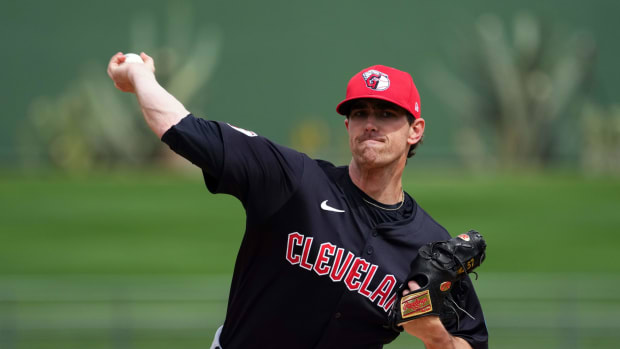Remember Mike Trout? MLB’s Best Player Is Back With More to Prove
Like a gunshot in a forest, a clarion blast pierced the quiet of the back fields at the Angels’ spring training complex, where Double A and Triple A preseason games between the Angels and Rockies played out on adjacent fields in front of no more than two dozen spectators. It was the unmistakable sound of major league contact. Mike Trout, batting in the Double A game as a tune-up for the season, ripped a long home run off a minor league Rockies pitcher who never had seen such bat speed and strength.
As Trout rounded the bases, an Angels coach watching the Triple A game and alerted by the sound of such contact walked the 25 feet to the Double A diamond. “Let me guess,” the staffer said, “breaking ball in the zone?”
Correct. The pitch was a slider over the plate. To paraphrase Jim Croce, you don’t tug on Superman’s cape, you don’t spit into the wind and you don’t mess around with a breaking ball in the zone to Trout. Over the past four years, Trout has slugged an MLB-best .847 on breaking balls in the zone. Nobody else is within 98 points of him.
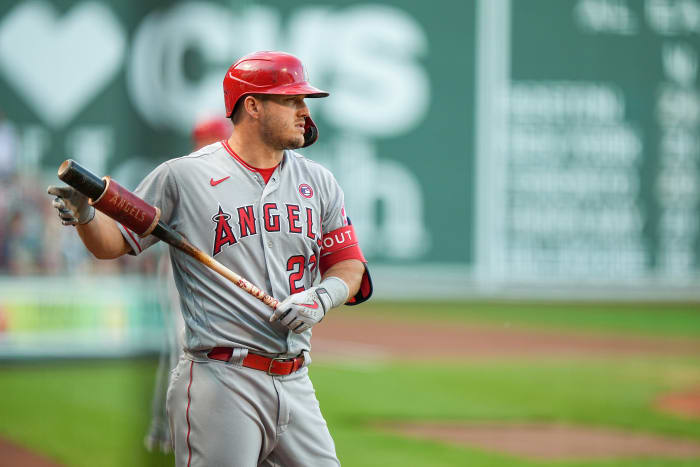
Trout has been so good for so long that it’s easy to take him for granted.
Erick W. Rasco/Sports Illustrated
But it is easy to forget what Trout can do, whether you’re a Double A pitcher or an average fan. COVID-19 and injuries have done to Trout what pitchers could not do for years: stop him cold. Over the previous five years, covering his age-25–29 seasons, Trout has played only 477 games. That’s just 95 games per year, making for one of the greatest missing chunks of a historically great player’s prime. Since World War II, no Hall of Fame position player has logged fewer games in those five prime age seasons than Trout. (Edgar Martinez played 508 in those years, the fewest.)
Trout is still the best player in baseball, but now he must reprove it. As a calf injury limited him to 36 games last year, players such as Fernando Tatis Jr., Juan Soto, Vladimir Guerrero Jr. and Shohei Ohtani made a case for who’s got next. I ask Trout whether he should still be considered the best player in baseball.
“I don’t worry about any of that,” Trout says. “I know what I’m capable of. I know if I go out there for a full season, I’m going to be the best player on the field. I’ve always had that mentality, that mindset. And I know it.
“I feel like I’m getting better each and every year. I’m learning more.”
Brace yourself: Trout, one of the game’s greatest phenoms, turns 31 in August. He is a husband and father and begins his 12th major league season. He is not old. It’s just that the game gets harder after injuries and after 30, especially as it skews younger. The past 26 full-season MVPs were all 29 or younger on Opening Day in the year they won the award.
It’s been 10 years since Trout burst on the scene with a .326 average and 129 runs (still career highs), replacing Ted Williams as the youngest player with a 10-WAR season. He was the outlier who seemed fully formed as the Rookie of the Year. Trout has been so good for so long—this is the first season in a decade he is not coming off a top five MVP finish—that it’s easy to take him for granted.
But I wondered, how has he changed over the past decade? Sure, he has become much more of a devastating pull slugger, and though he has not lost any speed (his sprint speed last year was faster than it was seven years ago), he is not the same threat to steal bases. We can measure those changes easily. But to get the real answer of how Trout has changed since his Rookie of the Year season I knew where I had to go: Trout himself.
“A lot of people when I started out told me—mainly Albert [Pujols]—just to slow down the big moments,” Trout says. “When you first get called up, it’s a big moment. Bases loaded in the ninth inning? It’s a big moment. Even if the bases are loaded in the sixth inning, it’s a big moment. When you’re a young athlete it’s a big moment every chance you get with a runner on base.
“And slowing that down is hard to do because you have so much adrenaline, and you’re pumped, and your mind is going everywhere. You don’t realize that until you get up here and have those feelings and experience it.”
Trout’s rookie year was Pujols’s first with the Angels, but the first baseman was far from the only star Trout could turn to for guidance. The 2012 Angels were loaded with veteran talent. Trout shared the outfield with Torii Hunter and Vernon Wells, who between the two of them ended their careers with eight All-Star appearances, 12 Gold Gloves and three Silver Sluggers. Their rotation featured five former All-Stars, including ace Jered Weaver, who would finish third in the Cy Young voting after coming in second the year before and fifth in ’10.
“I used to pick his brain about what pitchers were trying to do,” Trout says of Weaver. “I had a lot of great veteran leaders when I first came up. It helped me.”
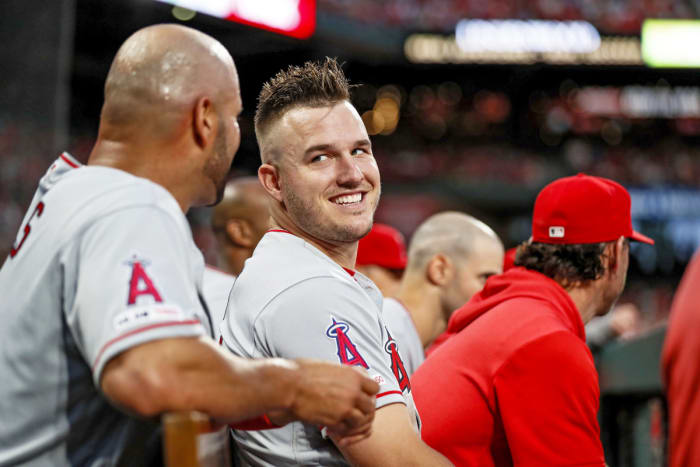
Pujols was a three-time MVP when Trout emerged as an outlier who seemed fully formed as the 2012 Rookie of the Year.
David E. Klutho/Sports Illustrated
The Angels called up Trout to stay for good in the majors on April 28, 2012, to replace another former All-Star, Bobby Abreu, whom they released. Trout started 0-for-8 before he ripped a double off Twins pitcher Nick Blackburn.
“I don’t remember it,” Trout says. “It was a long time ago.”
I ask him whether there was a moment when he knew he belonged in the majors.
“I didn’t realize it until probably the offseason,” he says. “During the season you’re in a groove, and I try not to get caught up in that stuff. Just go out there and play.
Trout finds it ironic that he replaced Abreu, whom he played with briefly the previous year.
“The way his approach was, early in my career that’s how I was,” Trout says. “I don’t think he ever swung at a first pitch. Early in my minor league career I always took a strike. I don’t know why, whether it was because they told me to, or it might have been that that was the game plan—see some pitches—somewhere in the rookie league or instructional league.
“I trained my body and my mind for those few years where I was comfortable hitting with two strikes. I was comfortable hitting 2–1, 3–1. But 2–0, 0–0? No. Not comfortable. It was weird. It was something I had to adjust to. Obviously as you move up in the minor league system you start to realize you only get a few pitches to hit. Maybe one, maybe one or two in the whole game, and you can’t miss them.”
From 2012 to ’15, Trout took the first pitch 90% of the time. Starting in ’16 he has cut that take rate to 82%, including 75% last year. Is it working? Since ’16, Trout has slugged .989 on first pitches, making him the best slugger in baseball on first pitches over those seven seasons (minimum 175 at bats).
The swing Trout has today is the same one he had in 2012. It is the most connected swing in baseball. His short arms never stray too far from his body. He hits with an upright stance and brings his hands down to low pitches faster and better than anybody in baseball. (Just watch his warmup swings; he essentially signals pitchers the natural arc of his swing.)
The foundation to his swing is getting his front foot down in time after his leg kick. When he is struggling it almost always is because his foot is down a hair late.
Trout’s swing did not change over a decade even as a torrent of information and technology sent many hitters into hitting “labs” to create Frankenstein swings.
“It’s been the same for me: less is more,” Trout says.
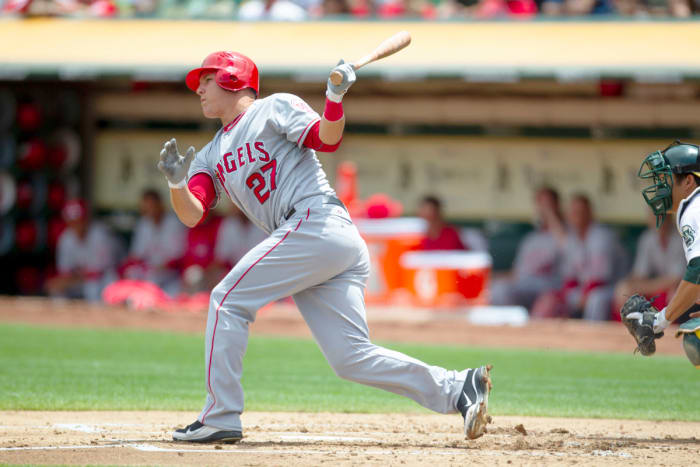
Trout has never altered his swing, despite playing in an era when players flock to hitting labs to revamp their hacks. His is the same now as it was in 2012.
Brad Mangin/Sports Illustrated
The only information he wants is a pregame scouting report of the opposing pitcher to see which pitches he throws and how often he uses them.
“I just put that in my mind,” Trout says. “Then in tough situations or a long at bat you know what pitches he has. I try to visualize the pitch before the at bat.”
I ask, “Do you want to know what pitches he goes to with runners in scoring position or depending on count?”
“No, no,” Trout says, shaking his head. “I just want to keep it simple. ‘Here’s what he’s got: fastball, slider, maybe a change.’ Stuff like that. My approach has always been the same. I look fastball and just react to the off-speed.”
Trout, however, has folded some technology into his game since his rookie season. If he has a particularly good game—“where I don’t miss a pitch,” he says—he will tell hitting coaches Paul Sorrento and Jeremy Reed to archive those swings on their phone or computer.
“Then,” Trout says, “if something gets off track, we’ll go back to that. That helps me more than anything. A lot goes into it for me to be the best I can be every day. I want that same feeling at the plate every day.
“Even if I’m lying in bed at midnight and it’s on my mind, I’ll shoot Jeremy or one of the hitting coaches a text and say, ‘Hey, I need that video,’ and he’ll send it to me right away, within a half hour. It doesn’t matter what time of night it is. He’ll have side-by-side at bats from that night and when I was going good.
“I can basically pinpoint what I’m doing wrong. And they’ll look at it. The next thing is we’ll have a little meeting to go over what they think I should be fixing.
“Look, I can just go up to Perry [Minasian, the Angels’ GM], go up to the front office or Skip [Angels manager Joe Maddon] or Jeremy and say, ‘What do I need to work on?’ Because of all the video, the analytics. Every single little detail, they’ve got. They can say, ‘This is what you need to work on,’ and you can pinpoint it. Ten years ago, when I first came up, they didn’t have that.”
For instance, analytics showed Trout that in recent years his defense in center field was slipping, primarily because he was not getting good jumps.
“Going back to last year and years before, the numbers proved it. It’s been bad,” Trout says of his defense. “Honestly, I feel it every once in a while. Like, ‘Man, if I had a better jump, I could have caught that.’
“When you see the numbers and somebody tells me, ‘Hey, you can be better at this,’ I’m going to try to be the best I can be at that. I think it got away from me the last three years because I really didn’t know what I was doing wrong. I felt natural out there.”
To improve his jumps, Trout has adopted a drill in which a coach hits line drives, soft flies and ground balls to him from about 60 feet away. He will do so for between 10 and 15 minutes. Asked how often he does the drill, Trout says, “Every day. I do it every day, because my route efficiency has been great, but the first step is what I’ve been grinding on every day until it’s right. It’s come a long way already.
“It’s just a reaction drill. I’m getting that reaction to the ball when I’m that close. It’s getting that infield mindset and taking it to the outfield, then I’m going to be that much quicker because I have that much more time.”
When Trout reported to camp, he heard Maddon tell the media that he was considering moving Trout to a corner outfield spot. The idea was to save wear and tear on Trout based on his injuries and age. Trout immediately told Maddon he wanted no part of moving out of center field.
“He definitely meant something by that,” Trout says. “The facts are everybody knows that corner outfielders don’t run as much. And so over the course of a season it would definitely save my legs. But I wasn’t there yet. I still feel comfortable out there in center. I try to get better every year, and this is one thing I’m getting better at.”
One day in the Angels’ camp, as players loosened in the outfield, Trout egged rookie outfielder Jo Adell about taking the outfielders out to dinner.
“A big old steak dinner, too,” Trout told him. “And don’t tell me you don’t have the money. I know you were a first-round pick!”
Trout is entering a new phase in his career. He is paying it forward the way Pujols, Hunter, Howie Kendrick and Wells did for him. He also is teeing off on the back nine. Through age 27 Trout ranked among the 10 best players ever at that age in runs, total bases, home runs and adjusted OPS. He has fallen off that pace, but because of only injuries, not performance.
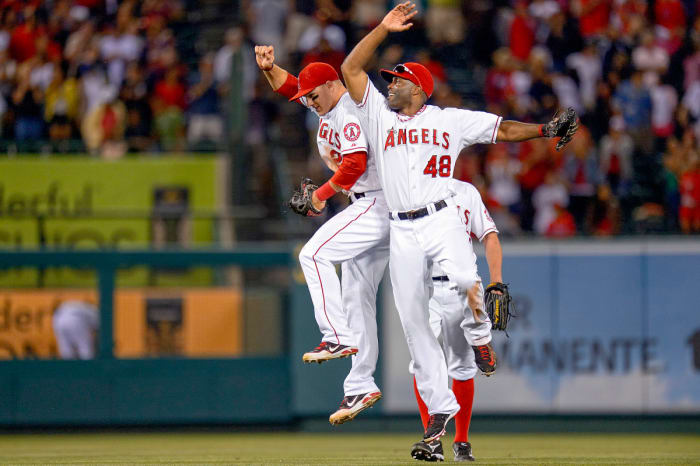
Hunter, a nine-time Gold Glove winning center fielder, had moved over to right field by the time he and Trout played together when Trout was a rookie.
John W. McDonough/Sports Illustrated
Over the past three years, for instance, he has hit the ball harder (91.7-mph average exit velocity) than he did in the preceding three years (90.4). He has taken 600 plate appearances in a season seven times—and either won the MVP or finished second in all seven of those seasons. If he gets that many trips to the plate this season, based on how his pull and home run percentages have risen, he likely will top his career high of 45 home runs—especially with Shohei Ohtani hitting in front of him and Anthony Rendon behind him. The trio played only 17 games together last season. If they stay healthy, and Minasian’s rebuilt bullpen holds, the Angels could contend for a postseason berth.
The futility of the Angels is another reason why Trout’s star has dimmed. They have fielded six straight losing teams for the first time since the 1970s. In Trout’s 10 full seasons they never have supported him with a pitching staff that ranked in the top third in the league—for the past three seasons it’s been one of the four worst. The Angels are the epitome of mediocre in 10 full seasons of Trout: 759–759.
Once, in 2014, did Trout and the Angels reach the postseason. The Royals swept them three straight games in the ALDS. Trout went 1-for-12 in the series as Kansas City exploited a hole in his swing with elevated fastballs. The Royals threw him 60% fastballs. It is Trout’s Kryptonite. He is a career .155 hitter on high fastballs (MLB average during his career on such pitches is .203), though he has learned to swing less often at them.
Since Trout made his major league debut in 2011, 27 of the league’s 30 franchises have won a playoff game. Only the Angels, Mariners and Twins have not. Trout is the only player among those three franchises to endure the entire drought.
The World Series championship has become a line at a deli counter: Pick a number and wait your turn. Eight teams in the past eight years have heard their number called. The Angels never seem to be close. I ask Trout whether he watched the postseason last year.
“Ah, a little bit,” he says half-heartedly.
“Were you too busy, or was it too painful to watch?” I ask.
“It’s both,” he admits. “Hopefully this is the year.”
It’s been six years since Trout played more than 140 games in a season, eight years since he played in the postseason, and 10 years since he flew like Superman to take a home run away from J.J. Hardy at Camden Yards, the play that announced, “Hello, world, I am here,” and, in his own words, “I am the best player on the field.” It can be that way again, as long as he is on the field.
More MLB Coverage:
• We Haven’t Seen the Best of Shohei Ohtani
• MLB Predictions for MVP, Cy Young and Rookie of the Year Awards
• MLB Regular-Season, Playoff and World Series Predictions
• One Big Question for Every American League Team
• One Big Question for Every National League Team































